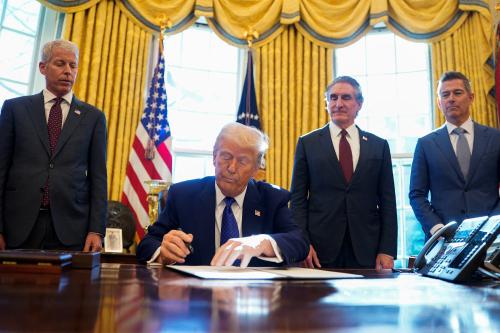In Unpacked, Brookings experts provide analysis of Trump administration policies and news.
THE ISSUE: In early February, President Trump issued an executive order directing the Secretary of Treasury to review the Dodd–Frank Wall Street Reform and Consumer Protection Act. The act, which was passed by President Obama in the wake of the 2008 financial crisis, serves as a comprehensive set of financial regulatory laws that seek to prevent future financial instability.
The fate of Dodd-Frank hangs more in the balance of the people put in place under the Trump administration to enforce it more than it does in Congress, where there will likely be many fights over how to rewrite the law.
THE THINGS YOU NEED TO KNOW:
- In early February, 2017, President Trump ordered a review of the 2010 Dodd-Frank Act. The Treasury Department will issue a comprehensive report on Dodd-Frank in June 2017.
- The 2008 financial crisis exposed significant weaknesses in the way U.S. banks and Wall Street are regulated. Dodd-Frank serves as a comprehensive set of financial regulatory laws, seeking to prevent future financial instability.
- The review, initiated by President Trump’s executive order, evaluates federal independent financial regulatory agencies that administer Dodd-Frank. These agencies include: The Fed, the Office of the Comptroller of the Currency (OCC), the Federal Deposit Insurance Corporation (FDIC), the Commodity Future Trading Commission (CFTC), the Securities and Exchange Commission (SEC), and the Consumer Financial Protection Bureau (CFPB), established in Dodd-Frank.
- The Treasury Department is tasked with determining what is and isn’t working, and what can be improved under Dodd-Frank.
- Currently, independent financial regulators are interpreting Dodd-Frank and choosing to enforce as they see fit.
- Congress is likely to re-evaluate Dodd-Frank. There will likely be debate over whether to implement a series of alterations to Dodd-Frank or an attempt to eliminate it altogether.
- There’s tension surrounding this report between the independent financial regulators, the White House, and Treasury Department, who are closely aligned with the Trump administration.
- Ultimately, the fate of Dodd-Frank hangs more in the balance of the people who are going to be put in place under the Trump administration to enforce and administer the law than it does in Congress where there will be debates over how to rewrite the law.
The Brookings Institution is committed to quality, independence, and impact.
We are supported by a diverse array of funders. In line with our values and policies, each Brookings publication represents the sole views of its author(s).





Commentary
Trump’s executive order on Dodd-Frank
March 20, 2017